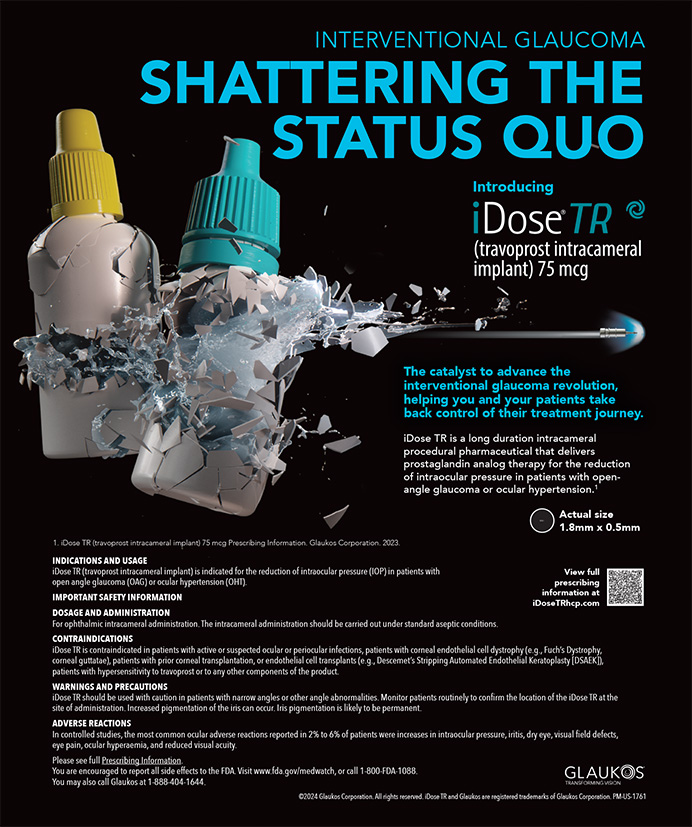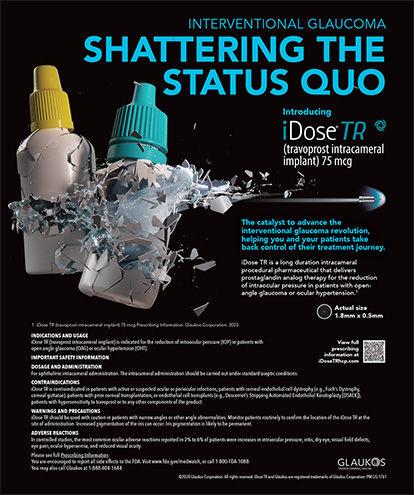Small incisions and technological advances have rendered today's cataract surgery far more a refractive procedure than it was in the past. Both patients' and surgeons' expectations have risen accordingly. As they strive to maximize patients' visual outcomes, ophthalmologists often focus on surgical technique and IOL technology. The importance of the ocular surface and pharmaceutical prophylaxis to visual outcomes, however, cannot be overstated.
PREVENTING INFECTION
Topical antibiotics are the gold standard for prophylaxis against infection in cataract surgery, and fluoroquinolones are today's first-line agents, provided patients have no allergies or sensitivity to these drugs. The most commonly used fluoroquinolones in cataract surgery are gatifloxacin (Zymar; Allergan, Inc., Irvine, CA), moxifloxacin (Vigamox; Alcon Laboratories, Inc., Fort Worth, TX), and levofloxacin (Quixin; Santen, Inc., Napa, CA). Bausch & Lomb (Rochester, NY) is awaiting approval of besifloxacin.
Most cataract surgeons, including myself, have patients begin using a fluoroquinolone q.i.d. 3 days before surgery. In an effort to sterilize the ocular surface and lid margins to the extent possible preoperatively, I recommend combining this antibiotic therapy with a lid scrub. Options include SteriLid (Advanced Vision Research, Woburn, MA), which is preferable to baby shampoo. I favor SteriLid for its antimicrobial properties. I instruct patients to begin cleaning their eyelids and eyelashes with this product 3 days preoperatively.
I used to have patients stop their antibiotic 1 week after cataract surgery. Based on the evidence of a spike in the incidence of endophthalmitis around 9 days postoperatively,1 I now instruct patients to continue antibiotic therapy for 2 weeks after the cataract procedure. Specifically, my patients instill gatifloxacin q.i.d. for 2 weeks after cataract surgery and then taper the dose to b.i.d. until the bottle is empty (typically 4 to 6 weeks postoperatively).
PREVENTING INFLAMMATION
Cystoid Macular Edema
After cataract surgery, many ophthalmologists prescribe minimal anti-inflammatory therapy, because they believe that the procedure does not incite a great deal of inflammation. If this decision were based on cell and flare alone, I would agree. Certainly, numerous studies have shown that a nonsteroidal anti-inflammatory drug (NSAID) alone effectively controls inflammation of the anterior segment.2-6
Recent research, however, has demonstrated that what was once thought to be clinically insignificant cystoid macular edema (CME) is in fact significant.2 Although this condition may resolve on its own or after NSAID therapy, investigators have now shown that patients' quality of vision (as measured by contrast sensitivity testing) is never as good after the resolution of CME as it was preoperatively. Preventing CME is therefore clearly preferable to treating it. Various NSAIDs are available for this purpose. Commonly used agents include bromfenac (Xibrom; Ista Pharmaceuticals, Inc., Irvine, CA), diclofenac (Voltaren; Novartis Pharmaceuticals Corporation, East Hanover, NJ), ketorolac (Acular LS; Allergan, Inc.), and nepafenac (Nevanac; Alcon Laboratories, Inc.). Allergan, Inc., should be releasing a new NSAID soon.
Patients should begin NSAID therapy q.i.d. 3 days before cataract surgery in order to stabilize the blood/aqueous barrier. Treatment should continue q.i.d for 2 weeks postoperatively and then b.i.d. for 2 to 4 weeks or until the bottle is empty. I prefer ketorolac.
Corneal Edema
Recent evidence suggests that corneal inflammation after cataract surgery may be clinically significant. The corneal endothelium is a part of the neural ectoderm. In their treatment of surgical and trauma patients, neurosurgeons administer high, pulsed doses of intravenous steroids peri- and postoperatively in order to minimize and avoid damage to neural tissue.7,8 In preliminary studies, Eric Donnenfeld, MD; Edward Holland, MD; and I found that high doses of a potent corticosteroid, difluprednate (Durezol; Sirion Therapeutics, Tampa, FL), significantly affected corneal thickness and edema after cataract surgery. Patients instilled four drops of the drug at home every 15 minutes starting 2 hours before surgery. They received three drops every 15 minutes when they arrived at the surgery center and administered the drug approximately hourly during the first day after surgery. Dosing then decreased to q.i.d. for 1 week and then b.i.d. for a final week, after which patients stopped the corticosteroid.
Based on our preliminary results, Dr. Donnenfeld, Dr. Holland, and I have begun a multicenter prospective clinical trial to determine whether frequent, high doses of a potent steroid immediately before and for the first 2 weeks following cataract surgery minimize corneal edema and improve outcomes.
CONCLUSION
I believe the pharmaceutical regimens outlined herein to be optimal for preventing infection and inflammation after cataract surgery. As ophthalmologists learn more about the incidence and causes of infection and about the inflammatory cascade, however, they will no doubt further refine their prophylactic strategies.
Kerry D. Solomon, MD, is a professor of ophthalmology for the Storm Eye Institute at the Medical University of South Carolina in Charleston. He is a consultant to Advanced Vision Research, Allergan, Inc., Bausch & Lomb, and Sirion Therapeutics. Dr. Solomon may be reached at (843) 792-8854; solomonk@musc.edu.
- Jensen MK, Fiscella RG, Moshirfar M, Mooney B. Third- and fourth-generation fluoroquinolones: retrospective comparison of endophthalmitis after cataract surgery performed over 100 years. J Cataract Refract Surg. 2008;34(9):1460-1467.
- Wittpenn JR, Silverstein S, Heier J, et al; Acular LS for Cystoid Macular Edema (ACME) Study Group. A randomized, masked comparison of topical ketorolac 0.4% plus steroid vs steroid alone in low-risk cataract surgery patients [published online ahead of print July 2, 2008]. Am J Ophthalmol. 2008;146(4):554-560.
- Sandoval HP, Fern‡ndez de Castro LE, Vroman DT, Solomon KD. Evaluation of 0.4% ketorolac tromethamine ophthalmic solution versus 0.5% ketorolac tromethamine ophthalmic solution after phacoemulsification and intraocular lens implantation. J Ocul Pharmacol Ther. 2006;22(4):251-257.
- Donnenfeld ED, Perry HD, Wittpenn JR, et al. Preoperative ketorolac tromethamine 0.4% in phacoemulsification outcomes: pharmacokinetic-response curve. J Cataract Refract Surg. 2006;32(9):1474-1482.
- Price MO, Price FW. Efficacy of topical ketorolac tromethamine 0.4% for control of pain or discomfort associated with cataract surgery. Curr Med Res Opin. 2004;20(12):2015-2019.
- Solomon KD, Cheetham JK, DeGryse R, et al. Topical ketorolac tromethamine 0.5% ophthalmic solution in ocular inflammation after cataract surgery. Ophthalmology. 2001;108(2):331-337.
- Vink R, Den Heuvel C. Recent advances in the development of multifactorial therapies for the treatment of traumatic brain injury. Expert Opin Investig Drugs. 2004;13(10):1263-1274.
- Ahn H, Fehlings MG. Prevention, identification, and treatment of perioperative spinal cord injury. Neurosurg Focus. 2008;25(5):E15.


